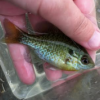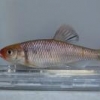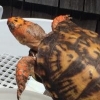Our neighbors haven't chlorinated their pool in five years, and it's now a pond. Current inhabitants are backswimmers, little black diving beetles of some sort, water stick insects, probably a bucketload of dragonfly larvae as soon as it's dragonfly season, and some sort of large fast diving beetle that I couldn't catch. Current vertebrates are toad tadpoles in all stages, leopard frog tadpoles that are mostly maturing now, and some bullfrog tadpoles. There are no mosquito larvae because they throw those mosquito donuts, the nematode-powered ones, into the pool now and then.
They'd like to add some sort of small predatory fish at this point, to help keep bugs from going out of control, and I also think predators might be a good idea. They have an enormous amount of tadpoles, which the predatory insects clearly can't catch up with, and I'm sure a lot of slow tadpoles that should have been eaten are morphing out. We're talking several hundred leopard frogs and probably thousands of toads every cycle. Waterbirds aren't showing up to help with control because they have a dog, but the dog ignores frogs.
The pool doesn't have a running filter, but there's always at least 3-4 feet of water, and it's just about full (10+ feet) right now. Water is pretty murky, but it doesn't stink or have any sort of a foam, and I suspect the presence of healthy tadpoles implies that the water is clean enough for sunfish. Would a few baby sunfish be a good addition, maybe bluegills? There's probably a deep layer of leaf litter and sticks by now, and they can throw in some cinderblocks or bricks for additional cover if it's needed. The aim isn't to wipe everything out, just to add some sort of a predator, so I'm guessing bass would be a bad plan.













